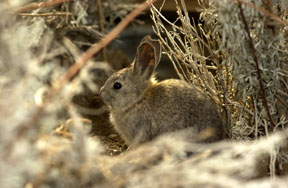
Photo courtesy Oregon Zoo.
This week’s cute endangered animal is the pygmy rabbit, which hails from my home state of Oregon, as well as Washington and Idaho. The pygmy rabbit is the smallest in the US, weighing just 1 pound. It’s also one of two wild rabbit species in North America that digs its own burrows, and communicates vocally with squeaks, squeals, and chuckles.
Despite the stereotype of rabbits breeding like, well, rabbits, the pygmy rabbit is quite close to extinction due to increasing agriculture, and possibly disease. The rabbits live pretty much on just one food source: sagebrush. Now you might think sagebrush is epic in the West: Is there a Western that’s complete without a tangle of sagebrush rolling through the dusty streets right before a shootout? But in reality, sagebrush is becoming less and less common in Oregon since the damming of the Columbia River created more arable land. As a result, dense sagebrush habitat is hard to find in the rabbit’s range, and pockets of it serve to isolate populations.
Until a few years ago, there were two sub-populations of pygmy rabbits: Columbia Basin and Idaho. As of 2002, researchers could only find 16 Columbia Basin pygmy rabbits in the wild, and in 2008, the entire sub-population went extinct when in 2008 the last known purebred Columbia Basin rabbit died in captivity. Since then, conservationists have mulled switching funds from the Columbia Basin preservation program to the Idaho program, since that sub-population is much healthier. Currently, the Oregon Zoo and other organizations are feverishly trying to breed the rabbits in captivity to create species biodiversity.















